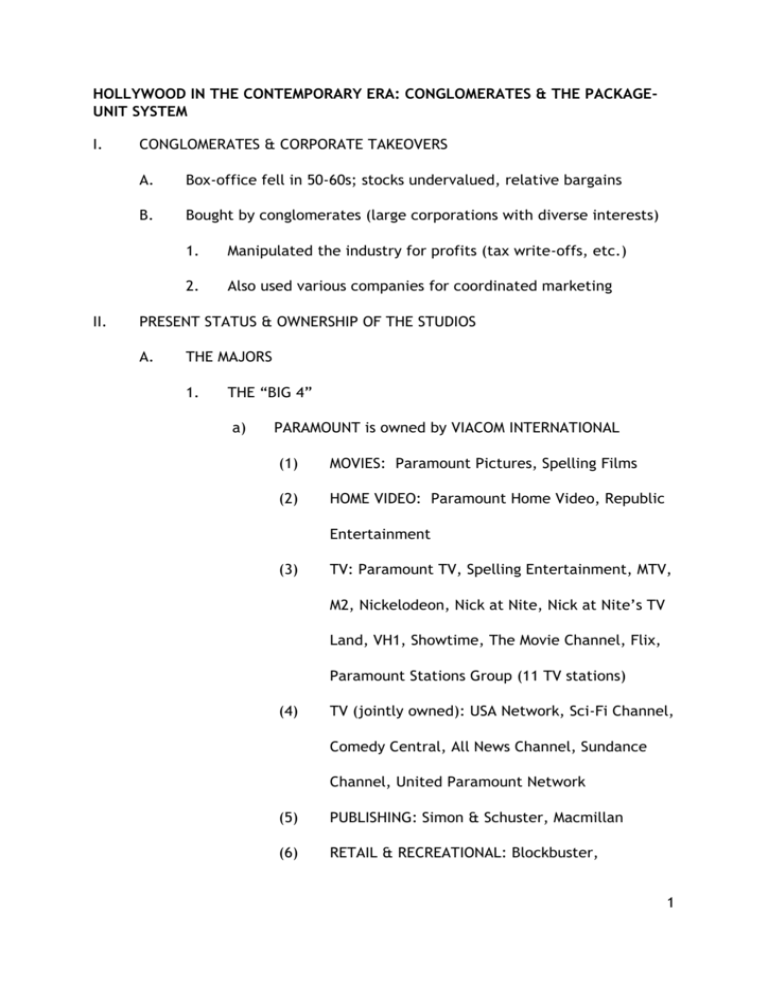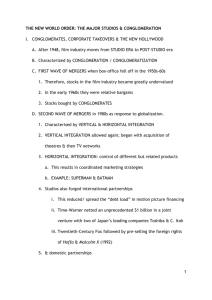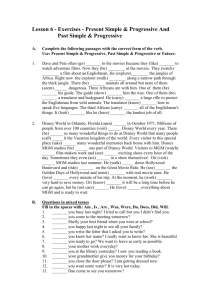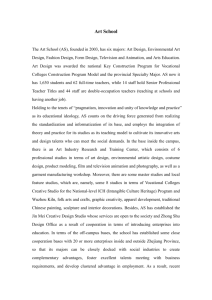hollywood in the contemporary era: conglomerates
advertisement

HOLLYWOOD IN THE CONTEMPORARY ERA: CONGLOMERATES & THE PACKAGEUNIT SYSTEM I. II. CONGLOMERATES & CORPORATE TAKEOVERS A. Box-office fell in 50-60s; stocks undervalued, relative bargains B. Bought by conglomerates (large corporations with diverse interests) 1. Manipulated the industry for profits (tax write-offs, etc.) 2. Also used various companies for coordinated marketing PRESENT STATUS & OWNERSHIP OF THE STUDIOS A. THE MAJORS 1. THE “BIG 4” a) PARAMOUNT is owned by VIACOM INTERNATIONAL (1) MOVIES: Paramount Pictures, Spelling Films (2) HOME VIDEO: Paramount Home Video, Republic Entertainment (3) TV: Paramount TV, Spelling Entertainment, MTV, M2, Nickelodeon, Nick at Nite, Nick at Nite’s TV Land, VH1, Showtime, The Movie Channel, Flix, Paramount Stations Group (11 TV stations) (4) TV (jointly owned): USA Network, Sci-Fi Channel, Comedy Central, All News Channel, Sundance Channel, United Paramount Network (5) PUBLISHING: Simon & Schuster, Macmillan (6) RETAIL & RECREATIONAL: Blockbuster, 1 Paramount Parks (6 theme parks), Theaters (Famous Players, United Cinemas International & Cinamerica), Bubba Gump Shrimp Restaurants (7) MISC: Viacom Consumer Products (toys, t-shirts & games), Viacom Entertainment Stores, Hamilton Projects (Spelling stuff), Famous Music, Viacom Interactive Services b) WARNER BROS. is owned by TIME-WARNER INC (1) Merger of Time & Warner Communications, then merged with Turner, now AOL (2) TIME INC. (a) MAGAZINES: Time, Fortune, Life, Sports Illustrated, Money, People, Entertainment Weekly, Southern Living, Progressive Farmer, Weight Watchers, Asiaweek (b) BOOKS: Time Life, Book-of-the-Month Club, Little, Brown & Co, Warner Books, Oxmoor House (c) OTHER PUBLISHING: Road Runner, Time Distribution Serv., Warner Publ. Serv., American Family Publ., Pathfinder (3) WARNER BROS. 2 (a) MOVIES & TV: WB, WB TV, WB TV Network, WB TV Animation, HannaBarbera, Telepictures Prod., WittThomas, WB International TV, Castle Rock (b) TIME WARNER CABLE: Full Service Network, NY1, Road Runner, West Valley Studios, Primestar (c) STORES: WB Studio Stores, HBO Store (d) WARNER MUSIC: Atlantic, Elektra, WB Records, Warner Music International, Warner/Chappell, WEA Inc, Ivy Hill, Reprise, Discovery Records, Rhino, Columbia House, Warner Music Canada (e) OTHER OPERATIONS: WB Domestic Pay-TV, Cable & Network Features, Warner Home Video, WB International Theatres, WB Consumer Products, WB Recreation Enterprises (Six Flags theme parks), DC Comics, Mad Magazine, WB Online (4) HOME BOX OFFICE: HBO, Cinemax, HBO Pictures/HBO Showcase, HBO Independent Prod., HBO Downtown Prod., HBO Animation, HBO 3 Home Video, HBO Sports, Time Warner Sports, HBO en Español, Cinemax Selecciones, HBO Brasil, HBO Hungary, HBO Asia, HBO Poland, HBO Home Satellite (5) CNN: CNN, CNN International, Headline News, CNN en Espanol, CNN Airport Network, CNNRadio (6) TURNER ENTERTAINMENT NETWORKS: Turner Entertainment, TNT, TBS, Cartoon Network, Turner Classic Movies, TNT Latin America (7) TURNER FILM PRODUCTION: New Line Cinema (& “art-film” subsidiary, Fine Line) 4 (8) OTHER OPERATIONS: Atlanta Braves, Atlanta Hawks, Atlanta Thrashers, World Championship Wrestling, Goodwill Games, Turner Sports, Turner Home Satellite, Turner Original Prod. c) WALT DISNEY (1) Disney now a conglomerate, a Major (2) MOVIES: Disney, Touchstone, Caravan, Hollywood Pictures, Miramax, Buena Vista International (3) TV: Buena Vista Home Video, Walt Disney TV, Walt Disney TV Animation, Disney Channel, Buena Vista TV, Disney TV International, ABC TV Network, ESPN, A&E Networks, Lifetime TV, Disney/ABC International TV, ABC-Owned TV Stations (10 stations) (4) Disneyland, Disney World, Tokyo Disneyland, Tokyo DisneySea (2001), Disneyland Paris (5) CONSUMER CRAP: Disney Interactive, Disney Magazine Group, Disney Store, Puppy Love (6) MISC: Anaheim Mighty Ducks, Anaheim Angels, Buena Vista Home Entertainment (interactive), Walt Disney Theatrical Prod. (The Lion King, New Amsterdam Theater in NY, etc), Hollywood 5 Records, Radio Disney, ABC newspapers & consumer magazines d) UNIVERSAL PICTURES (1) Bought by Matsushita, sold to Seagram (2) Seagram conglomerate includes: (a) LIQUOR, WINE & OTHER BEVERAGES (b) UNIVERSAL STUDIOS (c) TV PRODUCTION: Brillstein-Grey Entertainment, Universal TV Enterprises, Universal Family Entertainment, Universal Cartoon Studios, Inc. (d) UNIVERSAL MUSIC GROUP: MCA Records, Universal Records, MCA Nashville, Geffen, DGC, GRP, Rising Tide, Uptown Records, Curb/Universal & Interscope Records (e) THEME PARKS: Universal Studios Hollywood, Universal Studios Florida, Universal’s Islands of Adventure, Universal Studios Japan (2001) (f) MOVIE THEATERS: Cineplex Odeon Corp, United Cinemas International Multiplex, Cinema International Corp 6 (g) MISC: hotels & office buildings, Spencer Gifts (525 stores), Universal Studios New Media (entertainment software) 2. THE “LITTLE THREE” a) MGM/UA (1) Is owned by Denver millionaire KIRK KERKORIAN (a) Sold by Kerkorian a few years ago to TED TURNER, then sold back to Kerkorian (b) Sold to PATHÉ, known as PATHÉ/MGM (c) CREDIT LYONNAIS foreclosed, sold it back to Kerkorian (2) MOVIES & TV: MGM, United Artists, Samuel Goldwyn Pictures, Orion, MGM Worldwide TV, MGM/UA Telecommunications Group, MGM/UA Distribution, MGM/UA Home Entertainment (3) MISC: MGM/UA Music, MGM Interactive, MGM/UA Licensing & Merchandising b) 20TH CENTURY-FOX is owned by Australian newspaper magnate RUPERT MURDOCH’S NEWS CORPORATION (1) TV: Fox Broadcasting, Fox Entertainment, Fox Children’s Network, Fox Sports, Fox TV Stations (23 stations) 7 (2) MOVIES: Twentieth Century Fox, Fox 2000, Fox Searchlight, Fox Family Films, Fox Animation Studios, Fox Studios Australia (3) NEWSPAPERS: The Times (UK), New York Post, about 125 others c) COLUMBIA PICTURES (1) Purchased from Coca-Cola by SONY (2) MOVIES: Columbia, TriStar, Sony Pictures Classics, Sony Pictures Releasing, Columbia TriStar Film Distributors International (3) TV GROUP: Columbia TriStar TV, Columbia TriStar TV Distribution, Columbia TriStar International TV, Columbia TriStar Home Video (4) STUDIO FACILITIES: Sony Pictures Studios & Culver Studios (5) B. C. LOEW’S THEATRES: 1,018 screens,142 locations THE INDEPENDENTS 1. TROMA: Horror-comedies 2. CROWN INTERNATIONAL: Sleazy movies 3. DreamWorks SKG: Spielberg et al HORIZONTAL INTEGRATION 1. Typifies structure of the industry today 8 2. Single corporation controls different but related products; results in coordinated marketing strategies III. THE MAJOR STUDIOS’ RELATIONSHIP TO TV A. SUPPLIERS of Series Programming 1. Networks & cable companies serve primarily as distributors 2. TV supplied by small production companies & the Majors 3. PRODUCTION BY THE STUDIOS a) Film industry realized that TV production is costefficient b) B. (1) Sets can be reused (2) Programs can be produced in factory style The Majors’ own films may become sources for TV series (1) Use the physical properties of the movies (2) They already have a pre-sold audience DISTRIBUTION in the Electronic Age 1. Because 70% of films lose money at box-office, distribution includes (& depends on) TV, videocassettes, cable, etc. 2. IV. Films designed to appeal to these new forms of distribution THE PACKAGE-UNIT SYSTEM A. THE PACKAGE-UNIT SYSTEM replaced earlier systems of management 1. Reasons: Paramount Case; tax laws favoring independent production; changing demographics; advent of TV, etc. 9 2. Rather than mass production & run-zone-clearance distribution, these phases of the industry now vary from film to film B. DECREASE IN PRODUCTION 1. REASONS a) Studios no longer had theaters to supply b) Attendance was decreasing c) Studios made fewer, more expensive films, making more money on each (through longer runs in theaters) 2. THE DECREASE a) # of films fell 80% from 1930s (50 feature films/year/studio) to 1970s (10/year/studio) b) C. V. Increased in 1980s to 18-25 films/year/studio THE PRESENT STATUS OF THE MAJORS 1. Studios all parts of conglomerates 2. No contract system; negotiations & packaging instead 3. Primary function of Majors today is distribution INDEPENDENT or “PACKAGE-UNIT” PRODUCTION A. INTRODUCTION 1. Refers to movies made outside of the Major studios 2. Typical of film production today 3. Independent producer works in association with, but not under 10 the authority of, the studio 4. B. Film’s creation & financing must be “packaged” & negotiated “Package,” or pre-production preparation, consists of: 1. SCRIPT: Commissioned from professional scriptwriter, or provided by a free-lance, well-known author 2. PERSONNEL a) Contracts negotiated for cast & director (involving agents), technical crew (involving unions) b) Arrangements made for feeding, transporting, etc., the personnel 3. 4. DISTRIBUTOR a) Usually, a distributor must agree in advance b) Distributor should be 1 of the Majors FACILITIES: Sets, costumes, cameras, lights, etc. must be rented, usually from the distributing studio C. FINANCING THE INDEPENDENT PRODUCTION 1. Often, production corporation created for 1 movie & then dissolved; must go into debt to finance its film 2. THE SOURCES OF FINANCING a) 1ST MONEY (1) About 60% of the budget (2) Obtained from high-finance banks 11 (3) b) REPAYMENT: Principal plus interest (20-22%) 2ND MONEY (1) About 40% of the budget (2) Sources: (a) Direct investment & sale of stock (outside investors; producer, director, etc.; distributing studio) (b) Deferred salaries (POINTS of the film’s gross income) (3) c) 2nd money earns a share of the profits 3RD MONEY (1) Completion guarantee; covers costs over projected budget (2) Provided by an insurance company, finance company, or the producer (3) d) 3rd money earns a share of the profits Terms “1st, 2nd, & 3rd money” refer to order in which money is PAID BACK, not order in which it is obtained! D. COMMERCIAL RELEASE 1. Average negative cost, 1996 = US$39.8 million ($9.3 in 1980); average cost of advertising & prints, $19.8 million ($4.3 in 1980) 12 2. Movies must gross 2½-4 times initial investment to be profitable 3. DISTRIBUTION OF THE BOX-OFFICE $ a) 50¢ goes to the exhibitor b) 25-30¢ to distributor (prints, advertising & distribution fee) c) 4. 20-25¢ to the producer Most films lose money in theatrical release, but may make money from TV & video, etc.; blockbusters make up for losers VI. THE ROLE OF THE MAJORS A. FINANCE: Help finance independent production (provide 2nd money) B. TECHNICAL FACILITIES: Rent these to independent producers C. DISTRIBUTION: most important aspect 1. DISTRIBUTION SYSTEM a) Sophisticated, nationwide system of offices & personnel b) Since each film is independently sold, it is prohibitively expensive & complicated for independents 2. ADMISSION CHECKS: Checks on admissions at theaters (cheating easiest at box-office) 3. ADVERTISING CAMPAIGN: Designs advertising campaign, each film’s advertising designed individually 4. DISTRIBUTION SCHEDULE: Schedules designed to fit type of film 13 a) SLEEPERS: booked in 2-3 theaters, more as word-ofmouth spreads b) TURKEYS: booked into as many theaters as possible with much advance publicity before word-of-mouth spreads 14







